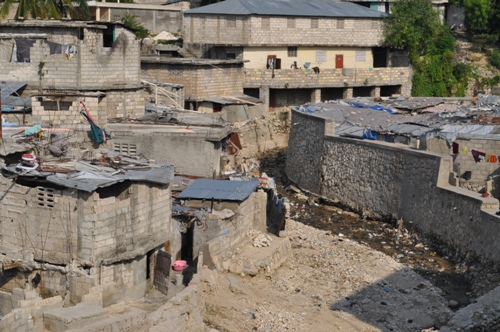Above: housing near Delmas 32 (Photo: Mercidieu Moranvil)
By Dieudonné Joachim
The already acute pre-earthquake housing problem in Haiti was magnified when 190,000 homes were destroyed or damaged after the Jan. 12, 2010 trembler. Even though the construction sector experienced a subsequent boom, there appears to be little change in building habits: permits are granted as routinely as they are requested.
ON A MORNING like any other, officers of the engineering department from Haiti’s provincial town of Léogâne decided to do a routine building inspection in the northern neighborhood of Chatuley. The new concrete structures were as incongruous as trees in a desert, just like the cost – some are well into the six-digit range.
Dismounting from their motorcycles, three inspectors exchanged greetings with the workers on the 100-square-metre site. Despite the day’s heat, the workers responded icily, as if they feared the inspectors’ presence would shut down their job, and ultimately their salary.
A heated conversation ensued and tempers flared. Onlookers already gathered in the shade of a mango tree threw in their opinion as the crowd, and the tension, grew. It was obvious that the workers did not have a building permit.
Even the arrival of Haitian police officers didn’t offer enough support for government officials to do their job. Eventually the inspectors, threatened by the size and tone of the throng, retreated, unable to enforce the laws designed to protect the lives and property of the population.
This case is far from isolated.
Whether it is Léogâne, Croix-des-Bouquets or Delmas, municipalities affected by Haiti’s January 2010 earthquake today still lack the technical means and competent personnel to issue permits that would force construction workers to respect the state’s new building requirements.
In Léogâne, the engineering department has only six employees: the chief, a deputy and four inspectors who have attended seminars of the Ministry of Public Works, Transport and Communications (MTPTC).
The process may be straightforward, but it is cumbersome and laden with pitfalls. To get a permit, an individual citizen puts in a request to the mayor’s office, which takes it to the MTPTC, which, in turn, either accepts or rejects the request. If it is accepted, the permit is issued from the mayor’s office to the individual..
“City Hall doesn’t issue more than 10 permits a month,” says Jean Ponny Charles, chief municipal engineer for the city of Léogâne.
“There have been no requests for from the city,” says Charles Hyginus Raymond, assistant director of public works in the MTPTC and head of the Technical Evaluation of Buildings Office (BTEB). “The problem of skilled human resources and adequate material is serious. It prevents city hall engineers from carrying out their responsibilities. His own office is in a room, void of computers, computerized registrars, global (IGPS) satellite positioning apparatus and personnel.
Léogâne, which has a population of about 200,000 residents, consists of 13 communal sections.
“Only three are in the plains; those in the mountains are simply neglected or abandoned,” says Charles, who is an electrical/mechanical engineer.
On average, electrical inspectors from the mayor’s office of Léogâne visit ten work sites per week. (In one instance, an employee had to rent a private vehicle in order to complete his inspections at the cost of $19/day).
Even if that number is higher than it was pre-earthquake, the head of Léogâne’s municipal engineering team admits it is still insufficient. And, he says, the 100-gourde tax per square meter (US$2.50) for residential construction is not high enough. Taxes vary according to townships. That being said, most homeowners would like to see that tax abolished.
Léogâne: one case among others
“Despite the fact that we have a tax of 75 gourdes (US$1.90) per square meter of construction for a building and 50 gourdes (US$1.10) per square meter for a closing, too often we are unable to collect the money,” says engineer Ernso Rémy, head of the municipal service of the metropolitan town of Croix-des-Bouquets. This, despite ten MTPTC trained inspectors working full time.
By contrast, the operations of municipal engineering of Delmas City Hall Service has 19 inspectors, six engineers, three secretaries, two police officers and the support of the Street Brigade Control (Bricor).
In addition, it has two pickups, and a heavy equipment truck, far more than what is available to the Croix-de-Bouquets and Léogane municipalities.
But that doesn’t mean Delmas isn’t handicapped in the same way that other municipalities are.
Enock Lamy, who heads its service, says that his institution collects about three million gourdes ($750,000) per month but that money doesn’t necessarily return to his township. It goes to the tax office. To access the funds the process is time consuming and inefficient in a post-quake construction situation. Each City Hall must apply to the Ministry of the Interior, which in turn writes to the Ministry of Finance, which releases these funds to the DGI. The process must be reversed before the money is available for the municipalities from the National Credit Bank.
Haiti’s Construction Code
Haiti does not yet have its own building code, but since February 9, 2010, the MTPTC says it has been employing international codes, including ACI-318, Euro code 8 and the Canadian National Building Code.
The country’s own construction code is still being prepared by an international consortium – Norbati/SNC Lavalin/LGL S.A and is currently under review within several ministries.
Ultimately, it is the MTPTC that is responsible for the regulation of construction in Haiti. Before it grants the municipality permission to give out a permit, it asks the municipality for technical advice on such things as facades, draining, distribution of reinforcement, etc.
But the municipality has to solicit the Directorate of Public Works (DTP) which, through its urban planning department, checks it against the compliance standards. There must also be a cost estimate and a survey plan, and City Hall also requires that the engineer, architect or building company show its certification in order to prevent technical shortcomings in the building process.
It is rare to find permit requests submitted to the MTPTC by townships which do not lack one or more elements essential to the construction of buildings. Even if the titles are valid, the calculations are either absent or inaccurate, which, says engineer Charles Raymond, “gives us a bad reputation,” one he does not believe they deserve.
Heads of several engineering departments have expressed their frustration with the government, saying that it doesn’t understand the needs of the community. More autonomy, they argue, would help them raise money and if the revenue they raised remained in their community, there would be fewer problems.
If houses had been built according to code, chances are fewer people would have died during the earthquake.
The President and CEO of Miyamoto International and specialist of American-Japanese earthquake-resistant buildings, has provided useful tips for safer construction, such as how to bind columns with calipers or determine of the height of the stirrups.
According to an interview given to Haiti’s daily Le Nouvelliste in March 2010 Kit Miyamoto said the information “could have reduced by half the number of deaths caused by the January 12, 2010 earthquake.”
Unfortunately, says engineer Charles, the population’s attitude towards construction hasn’t changed much.
Building is happening without regard for existing standards, despite measures of control that are in place and a radio awareness campaign that has been aimed at helping the public avoid past mistakes. Still, people want to do construction their way, without restriction or input from the government.
Is it possible that townships would be more effective if they had more resources and that buildings would be safer if the existing codes were enforced?
The answers will only be known after the next major seismic activity, at which point it may be too late to save lives.
This report made possible with the support of the Fund for Investigative Journalism in Haiti.







